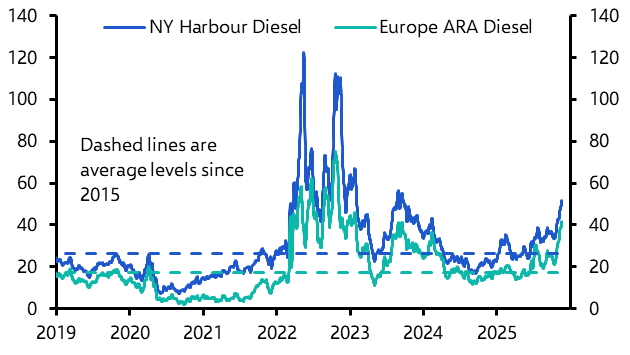I spent much of last week visiting clients in Europe. A frequent topic of discussion was our view that we’re witnessing the steady “Japanification” of Europe and, indeed, much of the developed world. This will have profound implications for growth, inflation, monetary policy and financial markets in the years ahead.
The term “Japanification” is really just shorthand for the fact that many of the challenges that dog the economies of the developed world today were first present in Japan twenty years ago. Among other things, this includes weak rates of growth and persistently low rates of inflation despite huge amounts of policy support, particularly from central banks. Yet the economics of Japanification are often misunderstood.
One important point to stress is that, on some measures at least, Japan’s economic performance has not been all that bad – or at least not so bad as to justify some of the more extreme headlines it has received. Since the start of this decade Japan’s working age population has contracted by around 0.5% a year. Yet despite this, GDP has increased by an average of 1.3% a year and GDP per capita has increased by an average of 1.5% a year. While this is not a stellar performance, it doesn’t amount to the “lost decade” of growth that some have used to describe Japan’s recent experience.
At the same time, Japan’s labour market has been strong. Unemployment is running at a record low and the participation rate is rising, meaning that overall employment has never been higher. And finally, predictions of an impending fiscal catastrophe caused by a large and rising government debt burden have (so far) proved to be unfounded. Instead, the economic problems posed by Japanification are threefold. The first is that the flip side of a high employment rate has been low rates of productivity growth and thus wage growth. Japan has responded to the challenges posed by a declining working age population by putting more people to work rather than raising the productivity of existing workers, but this can’t be sustained indefinitely. The second problem is that inflation has become entrenched at extremely low levels. And the final problem is that it has required super-loose monetary policies from Bank of Japan to deliver this result.
One important consequence of this is that the BoJ now has little ammunition to fight future downturns. This is a major concern because, if Japan were to be hit by a new deflationary shock at a time when nominal interest rates were already at their effective lower bound, real interest rates would necessarily rise. This would amplify any loss of output from the shock and spell disaster for asset prices. (You can read more about all of this on our dedicated Japan service.)
Of course, the extent to which the world’s developed markets have become “Japanified” varies. As things stand, the parallels look strongest in Europe and, in particular, the euro-zone and Switzerland. But it’s also the case that the Fed only managed to raise interest rates by 200bps in this cycle before having to reverse course - and demand conditions in the US have been helped by a large fiscal stimulus. Look closely, and to a greater or lesser extent, much of the developed world seems to be turning at least a little Japanese.
So what should we expect from here? The “Japanification” of the developed world doesn’t mean that growth can’t or won’t fluctuate from year to year. But in general terms, the macro environment in the developed world over the next 2-3 years is likely to be one of mediocre growth, low inflation and very low interest rates. Unemployment rates are likely to remain low, but the flip side of this will be weak rates of productivity growth and therefore wage growth. Somewhat paradoxically, this environment may actually justify higher levels of asset prices, since equilibrium interest rates are much lower. Asset returns, however, will be relatively low. (For more, see our new Asset Allocation service.)
What are the policy implications of all this? One emerging lesson from Japan is that, faced with rock-bottom interest rates, many of the country’s smaller banks are now trying to boost returns by investing in riskier assets. As things stand, they are probably too small to pose a systemic threat to the wider financial system. But it is an illustration of the potential distortions (and vulnerabilities) that can arise from a prolonged period of ultra low interest rates and suggests that macro-prudential policies to guard against such risks will assume growing importance in the years ahead. (We’ll have more to say on the risks posed by Japan’s smaller banks in forthcoming research.)
Another lesson from Japan is that governments that can issue local currency bonds at very low rates of interest can sustain surprisingly large debt burdens. In such an environment the fiscal judgement starts to change and governments have more room to keep fiscal policy loose in order to sustain demand and maintain full employment. Warnings that large debts and deficits in parts of the developed world (notably the US) will inevitably lead to fiscal crises are, for the most part, likely to be proved wrong. However, not every country in a “Japanified” world has greater fiscal leeway. This is especially true of those governments with weaker balance sheets in the euro-zone, where the ECB can’t (or won’t) stand behind sovereign bond markets in the same way the BoJ can in Japan.
This reinforces the point that, while much the developed world is displaying at least some Japanese characteristics, the extent to which this shapes the economic outlook varies. The outlook for the US is perhaps best described as “Japan-lite”, with growth and inflation likely to be weak but not as weak as Japan has experienced in recent years. In contrast, the challenges facing the euro-zone look much more substantial. Indeed, a Japanese outcome may actually be the best possible one right now.
So the developed world appears to have entered a period of Japan-style low growth, low inflation and super-loose policy. What about the emerging world? Well, the good news is that the issues I’ve outlined in this note only affect those countries at the technological frontier. In that sense, the emerging world is immune to all of this. The bad news, however, is that emerging markets are facing challenges of their own. I’ll return to these in next week’s note.
In case you missed it:
- Our UK team is covering the economic and market consequences of next month’s election in detail, including with this handy “Election and Brexit scenarios” calculator.
- Our markets team have published their latest Outlook, which includes new (less bearish) forecasts for equities.
- Our Senior Economic Adviser, Vicky Redwood, pulls together the headlines from our recent work on the future of globalisation in one short note.





